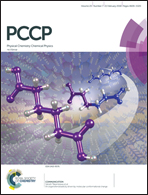QM/MM studies on the excited-state relaxation mechanism of a semisynthetic dTPT3 base†
Abstract
Semisynthetic alphabets can potentially increase the genetic information stored in DNA through the formation of unusual base pairs. Recent experiments have shown that near-visible-light irradiation of the dTPT3 chromophore could lead to the formation of a reactive triplet state and of singlet oxygen in high quantum yields. However, the detailed excited-state relaxation paths that populate the lowest triplet state are unclear. Herein, we have for the first time employed the QM(MS-CASPT2//CASSCF)/MM method to explore the spectroscopic properties and excited-state relaxation mechanism of the aqueous dTPT3 chromophore. On the basis of the results, we have found that (1) the S2(1ππ*) state of dTPT3 is the initially populated excited singlet state upon near-visible light irradiation; and (2) there are two efficient relaxation pathways to populate the lowest triplet state, i.e. T1(3ππ*). In the first one, the S2(1ππ*) system first decays to the S1(1nπ*) state near the S2/S1 conical intersection, which is followed by an efficient S1 → T1 intersystem crossing process at the S1/T1 crossing point; in the second one, an efficient S2 → T2 intersystem crossing takes place first, and then, the T2(3nπ*) system hops to the T1(3ππ*) state through an internal conversion process at the T2/T1 conical intersection. Moreover, an S2/S1/T2 intersection region is found to play a vital role in the excited-state relaxation. These new mechanistic insights help in understanding the photophysics and photochemistry of unusual base pairs.



 Please wait while we load your content...
Please wait while we load your content...